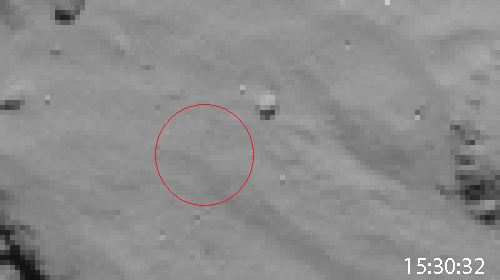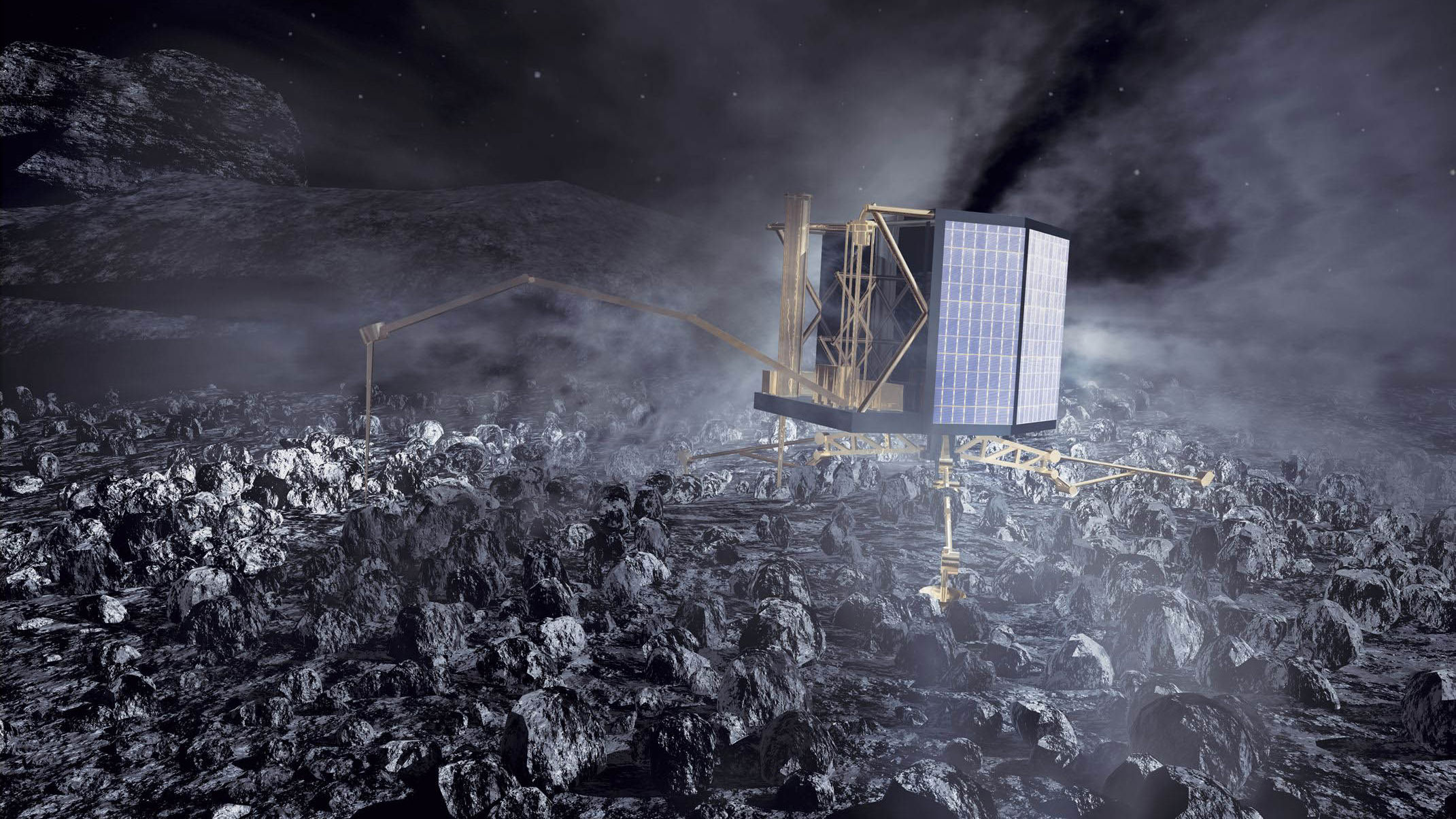Where is the Philae lander and will it wake up again? Those are the questions the team at the DLR Lander Control Center will be trying to answer starting this week. Thursday, March 12 provides the first possibility to receive a signal from Rosetta’s lander, sitting somewhere on Comet 67P/Churyumov-Gerasimenko.
“It could be that the lander has already woken up from its winter sleep 500 million kilometers away, but does not yet have sufficient power to inform the team on Earth,” said Koen Geurts from the German Aerospace Center (Deutsches Zentrum für Luft- und Raumfahrt) in a blog post today.

The lander has been sleeping in a shaded spot on the comet’s surface after its dramatic touchdown (actually, three touchdowns) four months ago on Nov. 12, 2014 when it flew, landed, bounced and then repeated that process for more than two hours across the surface. Scientists estimated it could have bounced as high as 3.2 kilometers (2 miles) before becoming wedged in a spot that –- at that time — didn’t get much sunlight. The solar-powered lander quickly ran out of power, just hours after landing.
The team admits they would be very lucky if a signal were to be received from Philae at the first opportunity, which is 05:00 CET on March 12, 2015 (midnight on March 11 EDT) when the communication unit on the Rosetta orbiter will be switched on to call the lander.
While the comet is coming ever-closer to the Sun, Philae needs to receive enough solar energy to activate a few systems before it can wake up and begin communicating.
“Philae currently receives about twice as much solar energy as it did in November last year,” said Lander Project Manager Stephan Ulamec from DLR. “Comet 67P/Churyumov-Gerasimenko and its companion, Philae, are now only 300 million kilometers from the Sun. It will probably still be too cold for the lander to wake up, but it is worth trying. The prospects will improve with each passing day.”
The team did give a caveat that several conditions must be met for Philae to wake up and start operating again. By no means is it a given that Philae will awake.
First, the interior of the lander must be at least at minus 45 degrees Celsius before Philae can wake up from its winter sleep. In addition, the lander must be able to generate at least 5.5 watts using its solar panels to wake up. The temperatures are significantly lower in the shadowed region where it sits (named Abydos, even though the exact location has not been identified) than at the originally planned landing location.
While hibernating, the lander has been gathering and storing as much power as possible to heat up and Geurts said that as soon as Philae ‘realizes’ that it is receiving more than 5.5 watts of power and its internal temperature is above minus 45 degrees Celsius, it will turn on, heat up further and attempt to charge its battery.
Then, once awakened, Philae will switch on its receiver every 30 minutes and listens for a signal from the Rosetta orbiter. This, too, can be performed in a very low power state, but Philae needs a total of 19 watts to begin operating and allow two-way communication.
My #lifeonacomet has just begun @ESA_Rosetta. I'll tell you more about my new home, comet #67P soon… zzzzz #CometLanding
— Philae Lander (@Philae2014) November 15, 2014
Until March 20, Rosetta will be transmitting to the lander and listening for a response. The team said the most likely time for contact is during the 11 flybys where the orbiter’s path puts it in a particularly favorable position with respect to the lander during comet ‘daytime’ – that is, when Philae is in sunlight and being supplied with power by its solar panels. Communication will be attempted continuously because Philae’s environment could have changed since the landing.
“If we cannot establish contact with Philae before 20 March, we will make another attempt at the next opportunity,” said Ulamec. “Once we can communicate with Philae again, the scientific work can begin.”
Once Philae wakes up and can transmit, it will first send data about the health of its systems.
“We will then evaluate the data. What is the state of the rechargeable battery? Is everything on the lander still functioning? What is the temperature? How much energy is it receiving?” said Geurts.
Then the team will determine if all 10 instruments will be able to function with the available power. If sufficient energy cannot be stored in the battery, the solar energy available during the comet daytime will determine whether a reduced version of the science operations can be performed.
Currently, scientists believe that Philae is in sunlight for 1.3 hours. A day on 67P/Churyumov-Gerasimenko lasts 12.4 hours. If the battery can be charged as planned, then science operations could be done even at night. But in the event that the rechargeable battery on board Philae did not survive the intense cold of its hibernation, the engineers are prepared. “We are working to ensure that we can operate the lander and its instruments at least during the comet’s daytime, when it is in direct sunlight.”
Also, new commands have been sent to Philae to optimize the heating and provide energy savings to improve its chances of communication with Earth. Even if Philae does not have enough energy yet to answer, it could receive and execute these commands. This is referred to as ‘blind commanding’ by the engineers, because the lander is initially very unlikely give them feedback.
Philae’s exact location is still being determined by looking at images acquired by the Optical, Spectroscopic, and Infrared Remote Imaging System (OSIRIS) on board the Rosetta orbiter.
Read more about Philae at the DLR website.


Fingers crossed for Rip van Philae!
btw,
why didn’t they opt to design a landing system that dissipates the energy?
A spring stores energy … don’t allow that to seep back into the system. (Unless wanted for attitude correction … or hopping halfway around an asteroid)
They did: the landing legs dissipated something like two-thirds of the energy, and then cold gas jets and harpoons were supposed to fire to secure it to the surface. If either of those two systems had worked, it would have stayed put.
so they created two additional systems to compensate the 1/3rd energy (enough to make it hop that much) which both failed.
how about just storing the full 3/3rd energy and decide to make about 9 controled hops with it?
remove two systems that are there to compensate a landingsystem and add two systems that control a hop.
something like humans have: knees, with an added lock system.
It would have bounced once and never came back down. The speed on the first bounce was well over 1/3rd the comet’s escape velocity, 0.39 m/s to 1 m/s.
Planning out several hops would be nearly impossible, anyway. We didn’t know enough about the surface topography to find that many suitable bouncing spots, there probably isn’t a big enough area that’s flat enough to bounce that many times anyway, and every bounce would bring a risk of something breaking or landing wrong and sending the lander spinning out of control. Plus it didn’t exactly have the precision of a manned NASA mission, and while the first bounce was fairly close to the target landing zone, the margin of error would be miniscule if you’re trying to map out several hops on a very rough comet.
Philae’s design gave it the best chance possible to land in one spot and stay there. It just didn’t work, unfortunately.
There seems to be alot of optimism about getting the gear working again. Solar power and batteries is like having acne in your brain. With a plutonium RTG we would not have had this problem. But I suppose that ESA doesn’t do plutonium. Only NASA, Russia, China and terrorists do that.
I recommend this SETI talk about Philae, by Jens Biele of DLR:
http://www.seti.org/weeky-lecture/rosetta-lander-philae-mission-landing-comet-67pchuryumov-gerasimenko